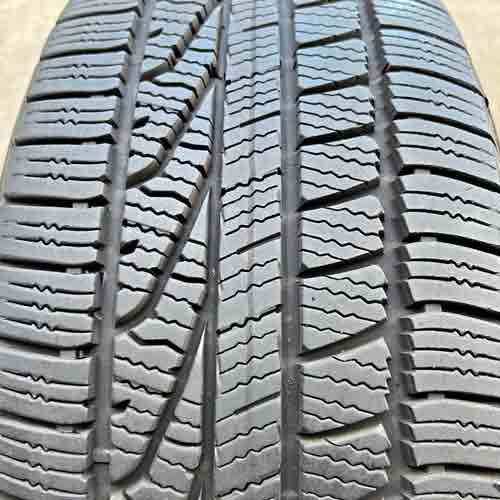Goodyear Assurance WeatherReady is a strong player in the all-weather tire category, giving you excellent traction on wet roads and lasting longer. When compared to many others in its category, it stands tall with its impressive performance in snowy conditions, (especially), offering a dependable and versatile choice for drivers.

Table of Contents
Sizes Facts
The Goodyear Assurance WeatherReady has sizes with following specs.
- Rim sizes: 15 to 20 inches.
- Speed ratings: T, H and V.
- UTQG: 700 A A.
- Load ratings: SL and XL.
- Tread depth: Either 10/32″ or 11/32″.
- Weight range: 19 to 37 lbs.
- Winter ratings: Yes both M+S/3pmsf available.
- Tread warranty: 60k miles.
Tread Design
Goodyear Assurance WeatherReady offers a uniquely engineered asymmetric tread design.

This intricate pattern features three distinct central ribs, each unique, and creating four longitudinal channels of roughly equal widths.
The central-most rib is almost continuous and comes equipped with lugs featuring sharply offset edges, notches, and lateral grooves within the tread. These lugs are further augmented by a mix of straight-line and interlocking sipes, enhancing both traction and stability.
Adjacent to this, the other ribs display more aggressive, you can say lug configurations.
One of them have zig-zag edges that harmoniously align with similar edges on the shoulder lugs, (I mean besides having the obvious chamfered edges and interlocking siping).
While the other rib comes with yet even sharper, you can say, needle like blocks (combined with other similar features).
As for the shoulder blocks, they are comparatively less aggressive in design, as they incorporate a mix of longitudinal and lateral straight-line sipes that are interconnected.
And yes, these shoulders also feature connectors within the smaller tread voids they form, adding an extra layer of intricacy to the design.
Compare Goodyear Assurance WeatherReady With Others
- Continental TrueContact Tour
- Michelin Crossclimate 2
- Michelin Defender 2
- Yokohama Avid Ascend GT
- Michelin Defender 2
- Bridgestone WeatherPeak
- Firestone WeatherGrip
- Pirelli Scorpion AS Plus 3
- Goodyear Assurance MaxLife
- Pirelli Scorpion WeatherActive
Dry Performance
On dry roads, the Goodyear Assurance WeatherReady is going to be very satisfying for you, as the tire does great in both, grip and handling departments.
Let’s discuss them separately below.
Steering Response
In simple terms, a tire’s responsiveness to steering input provides insight into its handling performance. In this regard, the Assurance WeatherReady delivers impressively sharp and linear feedback, largely due to its stiffer rubber compound.
When the tire navigates a corner, its rubber is pushed in the opposite direction, causing it to bend or flex, which can lead to either understeering or oversteering. The less pliable rubber of the WeatherReady minimizes this effect, resulting in crisp steering and agile handling, especially during quick transitions that don’t push the front tires to their grip limits.
However, during broader turns, this quick and direct steering response can be somewhat misleading. It may prompt the driver to make last-minute adjustments, often leading to undesirable understeering.
Nonetheless, when pitted against competitors like the Firestone WeatherGrip or the Avid Ascend, the Assurance WeatherReady consistently offers superior handling performance.
Directional Grip
Directional grip depends on the central part of the tread, where its seen how well the rubber to road connection is made.
And here, the Goodyear again showcases remarkable stopping capabilities (a way to directly measure this grip).
The tire not only offers a continuous middle rib and closely positioned surrounding ribs, ensuring optimal rubber-to-road contact, but you also get ton of notches everywhere, which bite in to the road’s surface.
Moreover, with chamfered edges (on lugs), the overall stopping efficacy is further enhanced, as it prevents the lugs from compressing excessively against each other during braking, facilitating a uniform distribution of weight across the tire and enhancing its grip and stopping power.
Wet Performance
Investigating the performance on wet roads, two primary aspects demand our attention: the tire’s ability to maintain grip on wet surfaces and its resistance to hydroplaning. Let us explore both dimensions.
Wet Traction
In wet conditions, the Goodyear Assurance WeatherReady exhibits a slight lag, mainly owing to its rigid structure.
This even goes for the SL sizes, which have a relatively softer dual-ply polyester, so they also restrict the flexibility of the sipes, impeding efficient water expulsion.
But why this flexibility so significant here?
Well, because sipes work by generating a negative pressure zones, so they (try to) suck up water particles coming underneath. They basically expand and contract, creating a slight vacuum, soaking up water in their slits.
And so with missing elasticity to the overall tread, they aren’t able to “flex” effectively. That’s why it makes sense why the Goodyear here is noticeably slippery.
With the limited traction, it compels you to slow down on corners, and if you try to push through, you get to face significant understeer, but yes, if you are a good enough driver, you would easily get the rear end to step out.
And yes, understeer is still always better than oversteering, am I right?
What I mean is that, in comparison to other all-season tires, its performance is not notably too inferior. But yes, its wet performance doesn’t fully match up to the expectations set by its dry road capabilities.
Hydroplaning
The hydroplaning resistance attribute of a tire is often not given the attention it deserves, even though it plays a vital role in ensuring overall wet traction.
Its basically related to how well a tire escapes water out through its main channels (aka grooves). And it gets measured through the float speed which indicates the maximum speed a vehicle can attain on water without losing grip.
Now here, the Goodyear Assurance WeatherReady impresses with four longitudinal channels featuring considerable tread depth.
And as these channels are interconnected via lateral grooves, too, you get efficient water cleaning in both directions, as seen by curved and straight aqua tests.
Snow Traction
The winter performance of the Goodyear Assurance WeatherReady stands out, managing well on both softer snow-covered paths and icy roads.
That’s why it makes sense why the tire is branded with both, the 3-peak mountain snowflake and the M+S symbols, highlighting its superb winter performance.
Basically snow tends to bond better to itself rather than to rubber, so with this tire having generous tread gaps, which function to scoop up snow, you get a above average traction.
Moreover, with numerous biters, in the form of zig-zag edges, chamfered edges and needle like grooves, you get ice traction with that as well.
Though one thing to keep in mind is that since the tire’s rubber composition isn’t that pliant, it tends to get stiffer with freezing temperatures.
Fuel Efficiency
When discussing fuel efficiency, it’s critical to note that it is inherently connected with friction the tread generates against the road.
That’s why it makes sense why its directly related to the tire’s weight, composition, and design.
Now with a light enough tire’s construction, the Goodyear Assurance WeatherReady does not exert a lot of stress on the lugs.
And as its overall tread compound is relatively stiffer, the lugs don’t undergo a lot of flexing as the tire maneuvers (and this saves up significant amount of energy).
Both of these features together allow this tire to have one of the best MPGs you can find in the category.
Tread Mileage
Just like the fuel economy, the tread life is also dependent on the tire’s rolling resistance, though other than that, its also dependent on the tire’s tread depth and rubber composition.
So where usually all season tires have up to 10/32″ of tread depth, the WeatherReady coming up with 1/32″ extra gets to wear out slower (reaching down to minimum legal tread depth of 2/32″ at a relatively slower pace).
Moreover, with less pliant tread, things get further durable, as the tire’s rubber isn’t that susceptible to burning out faster.
Ride Comfort
Delving into the aspect of ride comfort, one should know that its dependent on two major dimensions, tread noise dissipation, and tire’s ability to soak up the bumps.
And in both these scenarios, let me tell you, you are not going to be dazzled by the Goodyear Assurance WeatherReady.
The tire’s stiffer rubber compound struggles to absorb road vibrations, effectively transmitting the road’s irregularities directly to the passengers inside the vehicle.
However, it’s worth noting that the tire does a relatively decent job in terms of noise reduction.
Noise generation in a tire occurs primarily when air particles collide with the tread walls as the tire rolls. And the entry point for most of these air particles is through the shoulder voids.
That’s why in the case of the Goodyear Assurance WeatherReady, the tire features ridges that block these shoulder grooves, thereby limiting the amount of air that can penetrate.
As a result, with fewer air particles entering the tread, the tire generates fewer sound waves, making the overall noise level more tolerable.
Moreover, with asymmetric tread pattern, the tire is able to offer multiple points (across its design), where air particle hitting get to produce varying tones.
These varying frequencies then are able to prevent tread noise to get amplified.
To Sum Up
In summary, the Goodyear Assurance WeatherReady is a mixed bag.
It excels in dry conditions with strong grip and responsive handling but falls short in wet traction due to sipe inflexibility.
It offers good hydroplaning resistance and winter performance, but ride comfort and noise reduction are only moderate.
While its fuel efficiency and tread life are notable, the tire’s performance varies depending on the conditions, making it a versatile yet imperfect option.
I see that this tire is an asymmetric design. Is it also a directional tread design?
No directional tread designs are symmetric. Have you checked out my post… how to tell if your tires are directional? Check it out, finding it on the search bar.